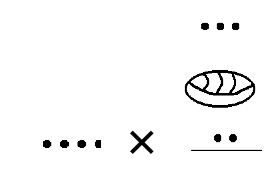4.3: Tareas
- Page ID
- 113215
- Envíe la tarea por separado de este libro de trabajo y grapa todas las páginas juntas. (Un elemento básico para la presentación completa de toda la tarea de la unidad)
- Inicie un nuevo módulo en la parte frontal de una nueva página y escriba el número de módulo en la parte superior central de la página.
- Las respuestas sin apoyar el trabajo no recibirán ningún crédito.
- Algunas soluciones se dan en el manual de soluciones.
- Puedes trabajar con compañeros de clase pero hacer tu propio trabajo.
Utilice la definición de adición repetida de multiplicación para calcular lo siguiente. Primero, escribe el significado de la multiplicación, y luego computa la respuesta.
| a.\(8 \times 4\) | b.\(4 \times 11\) |
Utilice la definición de adición repetida de multiplicación para calcular lo siguiente. Asegúrese de escribir el significado de la multiplicación en el sistema dado mostrando todo el trabajo y los intercambios. No hagas el problema en base diez.

Utilice la definición de multiplicación para trenes para calcular lo siguiente. Después traduzca para hacer una ecuación usando números.
| a.\(P \times W = \) _____ se traduce a _______________ |
| b.\(K \times W = \) _____ se traduce a _______________ |
Escribir el producto cartesiano
| a. {3, x}\(\times\) {0, 1, 6} | b. {a, b, 0}\(\times\) {1, 2} |
Usar la definición de multiplicación de la teoría de conjuntos para verificar\(3 \times 2 = 6\)
Completa lo siguiente usando tus bloques base. Mostrar todo el trabajo.
| a.\(F \times L\) | b.\(B \times L\) | c.\(F \times F\) | d.\(F \times B\) | e.\(B \times F\) |
Escribe la tabla de multiplicación base cuatro
Calcula lo siguiente\(2506_{\text{seven}} \times 451_{\text{seven}}\) usando el método de celosía.
| a.\(2506 \times 451\) | b.\(2506_{\text{seven}} \times 451_{\text{seven}}\) |
Calcular\(19 \times 24\) y\(24 \times 19\) usar el método Duplation. Mostrar todos los pasos.
Para cada conjunto de tres números dados, ilustrar un ejemplo de la propiedad asociativa de la multiplicación, y luego ilustrar un ejemplo de la propiedad distributiva de la multiplicación sobre la suma. Siga los procedimientos descritos en este módulo
| a.\(2_{\text{five}}, 3_{\text{five}}, 4_{\text{five}}\) | b.\(3_{\text{six}}, 4_{\text{six}}, 5_{\text{six}}\) |


